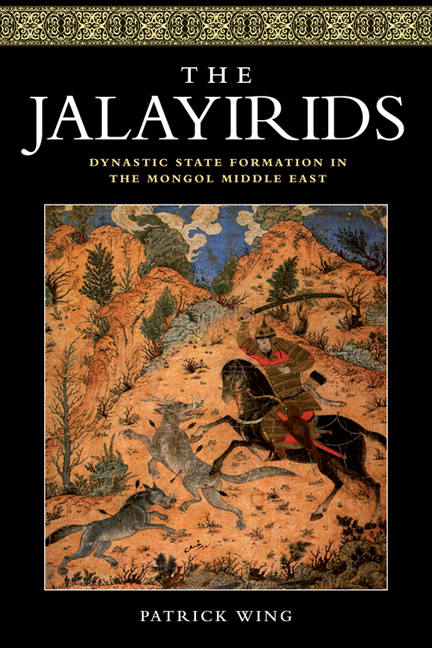Book contents
- Frontmatter
- Contents
- List of Illustrations
- Acknowledgements
- Abbreviations for Primary and Secondary Source Texts
- 1 Introduction and Sources for the History of the Jalayirids
- 2 Tribes and the Chinggisid Empire
- 3 The Jalayirs and the Early Ilkhanate
- 4 From Tribal Amirs to Royal In-laws
- 5 Crisis and Transition (1335–56)
- 6 Shaykh Uvays and the Jalayirid Dynasty
- 7 Dynastic Ideology during the Reign of Shaykh Uvays
- 8 Challenges to the Jalayirid Order
- 9 Conclusions and the Legacy of the Jalayirids
- Maps and Genealogical Chart
- Bibliography
- Index
1 - Introduction and Sources for the History of the Jalayirids
- Frontmatter
- Contents
- List of Illustrations
- Acknowledgements
- Abbreviations for Primary and Secondary Source Texts
- 1 Introduction and Sources for the History of the Jalayirids
- 2 Tribes and the Chinggisid Empire
- 3 The Jalayirs and the Early Ilkhanate
- 4 From Tribal Amirs to Royal In-laws
- 5 Crisis and Transition (1335–56)
- 6 Shaykh Uvays and the Jalayirid Dynasty
- 7 Dynastic Ideology during the Reign of Shaykh Uvays
- 8 Challenges to the Jalayirid Order
- 9 Conclusions and the Legacy of the Jalayirids
- Maps and Genealogical Chart
- Bibliography
- Index
Summary
In his chapter ‘The Jalayirids, Muzaffarids and Sarbadārs’ in volume six of the Cambridge History of Iran, Hans Robert Roemer characterised the period between the fall of the Mongol Ilkhanate and the arrival of Tīmūr in Iran as ‘grim and unedifying’, and mainly significant for its intellectual achievements, as well as for understanding Tīmūr's subsequent success in Iran. The period of fifty years, from c. 1335 to 1385, certainly witnessed examples of sublime cultural production; this was the period of Ḥāfiẓ, and the refinement of painted manuscript illustration, to name two important examples. In addition, indeed, a student of the Timurids must certainly strive to understand Tīmūr's campaigns in Iran in the context of the political situation that preceded them. Yet, there is a general sense among scholars of the late-medieval Middle East (what Marshall Hodgson called the ‘Later Middle Period’, roughly 1250 to 1500) that the middle of the fourteenth century east of the Euphrates river is best understood as a tumultuous transition between two important dynastic cycles, those of the Ilkhans and the Timurids. Additionally, this was a period of political breakdown with little to offer for our understanding of either the Ilkhanate or the Timurid and Turkman sultanates that followed in the fifteenth century. While the half-century in question certainly did see its share of ‘grim’ and tumultuous political conflict, the historical significance of the events of the period can only be fully understood if we consider continuities with the Ilkhanid past, along with the reality of the dramatic end of stability and dynastic order that took place following the death of Abū Sa‘īd Bahādur Khan in 1335.
We still know very little about the transition between the period of the Chinggisid Ilkhanate and the rulers that followed its collapse in the fourteenth century. Several amiral and local dynasties emerged following the death of Abū Sa‘īd. This study takes as its subject one of these post-Ilkhanid dynasties. The Jalayirid sultans, descendants of the Mongolian tribe of Jalayir, ruled part of the former Ilkhanid domains in the middle of the fourteenth century.
Information
- Type
- Chapter
- Information
- The JalayiridsDynastic State Formation in the Mongol Middle East, pp. 1 - 28Publisher: Edinburgh University PressPrint publication year: 2016
